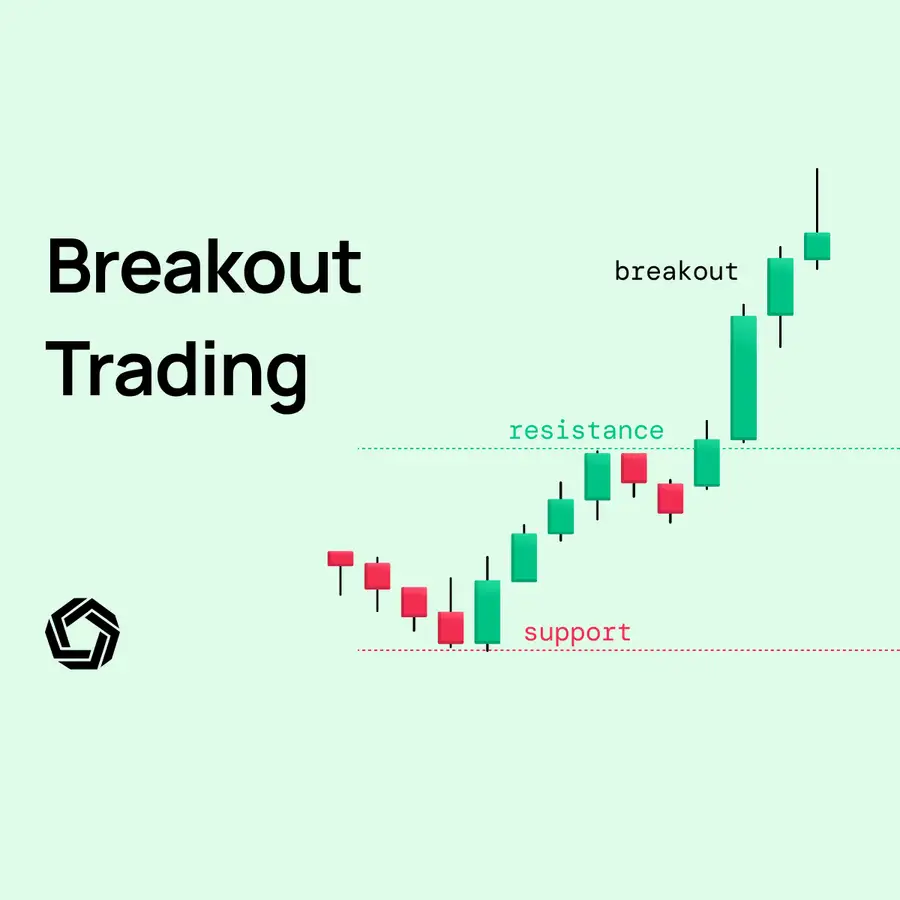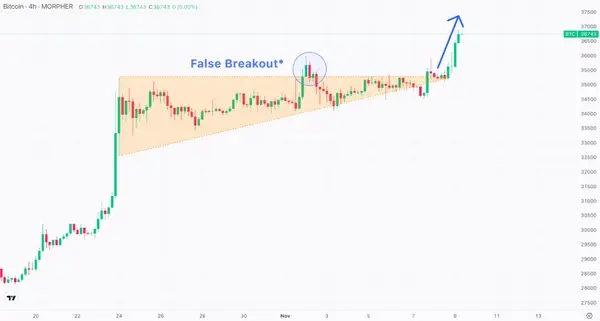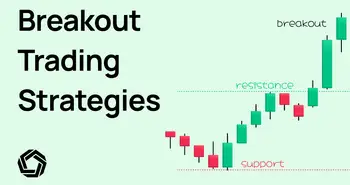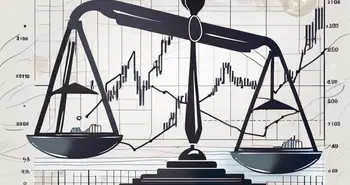Breakout Trading: The Only Guide You Need

Breakout trading is a straightforward strategy that traders use to capture the significant moves a stock makes when it crosses a defined boundary, known as support or resistance, with a noticeable increase in trading volume. Think of it as watching for the moment a sprinter bursts off the blocks — the strategy involves entering the race at just the right moment and riding the momentum that follows.
At its heart, breakout trading is about understanding and anticipating market psychology. When the price of a stock surpasses a well-established limit — either the ceiling (resistance) or the floor (support) — it’s a signal to traders that something significant is happening.
To put it plainly, imagine a rubber band stretched to its limits. Once it's let go, it snaps back hard and fast. In the market, when a stock price breaks past these limits, often due to compelling company news or market events, it tends to move sharply in that direction, as if snapping back with all the pent-up energy.
In this exploration of breakout trading, we will analyze the strategies of renowned investors and the advice from academic studies and financial literature, drawing parallels to the approaches of momentum trading professionals.
Understanding Breakout Trading
Breakout trading strategies are grounded in the conviction that price movements beyond key levels are significant and actionable. To continue our analogy, it's not just the sprinter's explosive start that matters — it's also the roar of the crowd that confirms the start is genuine and not a false start. In the markets, this roar is equivalent to strong trading volume accompanying a price breakout. Volume acts as a resonant confirmation, underscoring the legitimacy of the breakout and the presence of active market participation.
In a successful breakout trade, the initial surge in price must be corroborated by substantial volume, providing the confidence needed to enter a position. This volume serves as a barometer of market consensus, suggesting a collective agreement among traders that the price movement is meaningful and has the potential to develop into a sustained trend.
Moreover, breakouts often require a spark to ignite the move — a catalyst that convinces the market of the stock's new potential value. This could be an earnings announcement that surprises the market, a revolutionary product that disrupts the industry, or an executive shake-up that promises a fresh strategic direction. These events can drastically alter investor sentiment and lead to significant price shifts.
Consider the words of Nicolas Darvas, another trading legend, who said, “I just wait until there is money lying in the corner, and all I have to do is go over there and pick it up.” In the context of breakout trading, the “money lying in the corner” is the opportunity presented when a stock price clearly breaks a resistance level with supportive volume and a strong catalyst. The trader's job is to recognize this confluence of factors and act swiftly to capitalize on the ensuing momentum.
How Do Pros Approach Breakout Trading?
Successful breakout traders not only recognize these pivotal points but also understand the psychology behind price movements. Let’s delve into the strategies of market mavens who have mastered the art of breakout trading.
Paul Tudor Jones: Timing Precision
Paul Tudor Jones, a legendary trader, is famous for his timing precision in breakout trading. He emphasizes the importance of the breakout's quality, looking for additional confirmation in volume and market conditions to ensure that the breakout is not a false signal. His method involves a comprehensive analysis of market trends, economic conditions, and price action.
1. Establish a Solid Risk-Reward Ratio:
“I’m looking for 5:1 (risk/reward).” Prioritize trades where the potential profit is substantially higher than the potential loss. This means targeting breakouts that offer significant upside potential relative to the risk of the stop-loss just below the breakout level.
2. Prioritize Capital Preservation:
“I think I am the single most conservative investor on earth in the sense that I absolutely hate losing money.” Protecting your trading capital is paramount. Use stop-loss orders diligently to cut losses quickly if a breakout trade moves against you, thus preserving capital for future trades.
3. Master the Art of Reading Price Action:
“…at the end of the day, your job is to buy what goes up and to sell what goes down.” Analyze price movements and volume to confirm the strength and validity of the breakout. A true breakout should occur on high volume, indicating strong market support.
4. Maintain Emotional Discipline and Flexibility:
“I try to avoid any emotional attachment to a market.” Stay emotionally detached from your trades and be willing to exit quickly if the market conditions change. Flexibility in response to new information is crucial.
5. Seek High-Quality Breakout Opportunities:
“The sweet spot is when you find something with a compelling valuation that is also just beginning to move up.” An approach to consider is pinpointing stocks with reasonable valuations that are beginning to show upward price movements. Focusing on stocks with robust underlying fundamentals and discernible reasons for a potential increase in price may indicate opportunities for capitalizing on upward trends.
Linda Bradford Raschke: Strategy for Technical Breakouts
Linda Bradford Raschke, recognized in the field of trading, advocates for a trading approach grounded in technical analysis that values precision and flexibility. She acknowledges the inevitability of errors but stresses the importance of quick recognition and correction. Her strategy for trading hinges on this mindset and aims to exploit technical breakouts and reversals.
1. Analysis of Chart Patterns:
Raschke gives importance to chart patterns such as triangles, flags, and wedges, viewing them as indicators of potential market movements. She emphasizes the importance of detailed pattern analysis for anticipating market breakouts.
2. Confirming with Technical Indicators:
She integrates indicators like the RSI, Moving Averages, and the ATR to measure the strength and potential of a breakout. This layered approach helps validate the market's momentum and the likelihood of a trend continuation or reversal.
3. Volume Confirmation:
True to her belief that “a breakout with conviction will often be accompanied by an increase in volume,” Raschke looks for a volume surge as a nod that the market participants are solidly behind the breakout.
4. Precise Entry Points:
With precise entry points defined by the breakout's momentum, she advocates for “entering a trade as the price moves past a consolidation pattern's boundary,”. Here it is important to enter the market with high conviction.
5. Strict Risk Management:
Raschke takes risk seriously. She uses stop-loss orders to protect her trades and says that good traders, like good businesses, keep close track of their risks.
She also uses four different trading strategies to stay ready for market changes. Her main strategy is S&P day trading, which she does on days with lots of action in the market, and she isn't afraid to make big bets when things look right.
For her swing trading, she gets out quickly if a trade starts to lose, and she looks for momentum. Her charting strategy waits for false breakouts or for the daily price swings to signal a good trade.
Raschke's ‘everything else bucket' is for when the market is really extreme. She uses options to limit risk and pays attention to the seasons when trading commodities because that's when the big chances come.
She runs her trading like a business, regularly checking and adjusting her strategies. She fixes mistakes right away, just like she always says to do.
Raschke uses both her trading experience and systematic analysis when making models, using time-based exits to work well in any market.
Raschke's trading ideas are about more than just techniques. They're about having a disciplined, flexible approach and always checking your performance. That's how she's succeeded in trading.
Strategy 1: Real Breakout

The ascending triangle pattern is recognized as a bullish continuation pattern, signaling that an upward price trend is likely to continue after a brief period of consolidation. The strategy focuses on identifying these patterns and entering trades upon a breakout.
Spot the ascending triangle pattern on a 4-hour or daily chart for more reliability.
Look for a horizontal resistance line where the price has peaked but not broken through multiple times. Identify an upward-sloping trendline forming by connecting the higher lows of the price dips.
The entry signal is generated when the price breaks above the resistance level with increased volume. This confirms buyers are in control, and a potential uptrend may follow.
Wait for a candle to close above the resistance line to avoid false breakouts, as shown on the chart before. Optionally, look for a retest of the breakout level, where the price briefly dips to the resistance line, which now acts as support.
With a Bitcoin run, it is smart to set trailing stops to let profits run while protecting gains.
Always set a stop-loss just below the most recent swing low or the ascending trendline to minimize potential losses if the breakout fails. The risk-reward ratio should ideally be set at a minimum of 1:2, ensuring that the potential reward on the trade is twice the risk you're taking.
Trading Rules
- Chart Timeframe: Utilize a 4-hour or daily chart to identify clear ascending triangle patterns.
- Pattern Recognition: Confirm the pattern with at least two touches of resistance and higher lows touching the ascending line.
- Volume Check: Ensure that the breakout candle has higher than average volume for validation.
- Breakout Confirmation: Enter a long position only if the price closes above the resistance level.
- Stop-Loss Placement: Place a stop-loss just below the ascending trendline or the most recent swing low within the triangle.
- Risk-Reward Ratio: Aim for a risk-reward ratio of at least 1:2.
- Position Sizing: Adjust your position size to maintain a consistent risk per trade, typically not exceeding 1-2% of your trading capital.
- Exit Plan: Consider partial profits at the price target and use a trailing stop for the remaining position to capture any extended uptrend.
- Patience: Wait for the pattern to develop fully, and do not preempt the breakout.
Strategy 2: False Breakout & Reversal
The “Reversal” strategy aims to capitalize on the price movement following a false breakout. This scenario occurs when the price initially breaks through a key resistance level but fails to maintain momentum, resulting in a reversal and a subsequent bearish trend.

Look for a situation where the price breaks above a key resistance level. Observe the volume during the breakout. A false breakout often occurs on low volume, indicating a lack of commitment from buyers. Watch for a quick return below the resistance level, which signifies a false breakout.
Confirmation comes from a series of negative candlesticks that emerge after the price moves back under the resistance level, indicating a change in trend direction. A further confirmation is when the price breaks below a key support level following the false breakout.
Upon confirmation of the reversal, initiate a short trade. Place a stop-loss order just above the recently broken support level, now acting as resistance. Set a profit target at a level equivalent to the moving average or a previous support level to the downside.
Adjust the stop-loss order as the price moves in your favor to protect gains. Close the position either at the profit target or if the price action suggests a potential reversal against your trade.
Trading Rules:
- Chart Timeframe: Utilize a 1-hour chart to closely monitor price action and identify false breakouts.
- False Breakout Identification: Confirm the false breakout with a swift return below the resistance level and poor volume.
- Bearish Trend Confirmation: Look for a pattern of bearish candlesticks indicating a change in trend direction.
- Support Break Confirmation: Enter the short position only after the price closes below the key support level.
- Volume Analysis: Confirm the breakdown with an increase in selling volume.
- Stop-Loss Placement: Set a stop-loss just above the broken support level to minimize losses if the trend reverses.
- Profit Target: Set a conservative profit target at the next significant support level or moving average.
- Position Sizing: Risk no more than 1-2% of your trading capital on any single trade.
- Monitoring: Keep a close eye on the RSI (Relative Strength Index) for signs of oversold conditions, which might indicate a potential end to the bearish trend.
- Flexibility: Be ready to exit the trade if the price action shows signs of strength or a potential bullish reversal.
Strategy 3: Turtle Soup by Linda Braschke
We already wrote about Linda Braschke as a great inspiration for trading breakouts. In fact, she actually developed her own strategy called the Turtle Soup strategy. The Turtle Soup strategy is a clever twist on a classic trend-following system, conceptualized by the renowned trader Linda Bradford Raschke. This strategy operates under the premise that certain market conditions are prone to false breakouts, which can be exploited for potential gains. Here’s how the Turtle Soup strategy works in its essence:
Signal Identification:
- A buy signal is triggered when the price of an asset hits a new low over a 5-period span but then shows signs of a bullish reversal.
- Conversely, a short sell signal is activated when the price reaches a new 5-period high and then reverses to bearish.
Entry Points:
- Trades are entered at the close of the 30-minute period in which the new high or low was made, provided the price shows signs of reversing from these extreme points.
Filtering Signals:
- The strategy employs two exponential moving averages (EMAs), with periods of 21 and 30. These EMAs serve as a trend filter.
- If the 21-period EMA is above the 30-period EMA, the market is considered to be in an uptrend, and only buy signals are considered.
- If the 21-period EMA is below the 30-period EMA, the market is in a downtrend, and only sell signals are given weight.
Time Consideration:
- Raschke's original strategy recommends taking trades only between 06h00 and 22h00 to filter out lower-probability signals that may occur during less active market hours.
Stop-Loss and Exit Strategy:
- A stop-loss is placed at a distance of three times the 20-period Average True Range (ATR) from the entry point, acting as an emergency exit in case of extreme market moves.
- Positions are closed if the price reaches a new 5-period high (for long positions) or low (for short positions), ensuring that trades are exited during these short-term reversals.
The beauty of the Turtle Soup strategy lies in its contrarian approach, targeting scenarios where the market appears to be breaking out, only to reverse course. By capitalizing on these moments, the strategy aims to catch high-probability trades that benefit from the market's tendency to revert after making new short-term extremes. Linda Bradford Raschke's insight into these market dynamics offers traders a unique angle to approach the markets, particularly in fast-paced environments.
Conclusion
Throughout this article, we've explored the dynamic world of breakout trading, a strategy that waits for a stock to make a decisive move past a defined point of resistance or support, before joining the trend. We've likened breakout traders to attentive sprinters, poised at the starting blocks, ready to capitalize on the market's momentum as it surges forward. At least most of the traders have been active over the past 20 years of the trading world and seen other things.
Key takeaways include the significance of strong volume as a validator of genuine breakouts, much like the resounding applause of an audience confirms a sprinter's strong start. We've also highlighted the necessity of a catalyst — a fundamental change or event that propels the stock forward, providing the fuel for the breakout fire.
We've drawn from the wisdom of market mavens like Paul Tudor Jones and Linda Bradford Raschke who have employed variations of breakout strategies to achieve remarkable success. Their insights reinforce the idea that breakout trading, when executed with precision and supported by robust volume and a solid catalyst, can be a powerful tool in a trader's arsenal.
To conclude, breakout trading is not just about recognizing price movement — it's about understanding and interpreting the confluence of market psychology, volume, and catalysts to make informed trading decisions. By adopting the principles discussed, traders can navigate the markets with a strategy that has stood the test of time, offering opportunities to those ready to act when the market emphatically says, “It's time to move.”

Disclaimer: All investments involve risk, and the past performance of a security, industry, sector, market, financial product, trading strategy, or individual’s trading does not guarantee future results or returns. Investors are fully responsible for any investment decisions they make. Such decisions should be based solely on an evaluation of their financial circumstances, investment objectives, risk tolerance, and liquidity needs. This post does not constitute investment advice.

Painless trading for everyone
Hundreds of markets all in one place - Apple, Bitcoin, Gold, Watches, NFTs, Sneakers and so much more.

Painless trading for everyone
Hundreds of markets all in one place - Apple, Bitcoin, Gold, Watches, NFTs, Sneakers and so much more.









